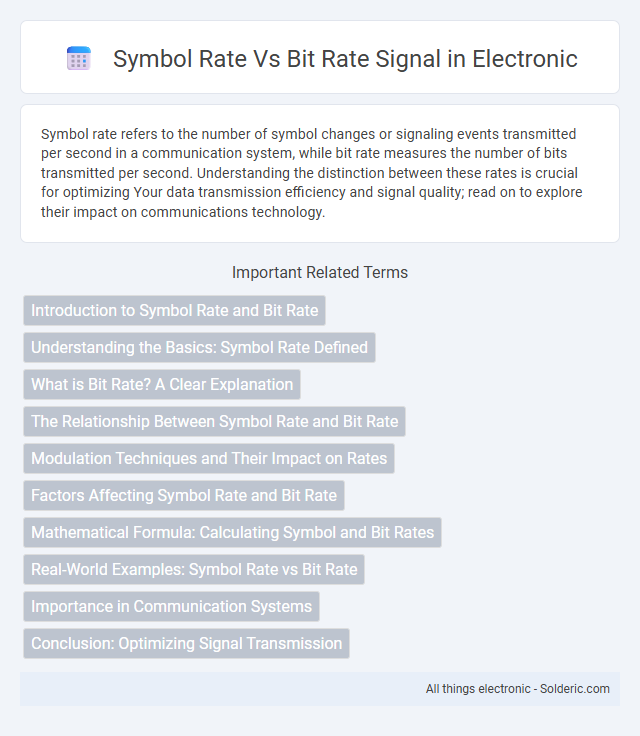Symbol rate refers to the number of symbol changes or signaling events transmitted per second in a communication system, while bit rate measures the number of bits transmitted per second. Understanding the distinction between these rates is crucial for optimizing Your data transmission efficiency and signal quality; read on to explore their impact on communications technology.
Comparison Table
| Aspect | Symbol Rate | Bit Rate |
|---|---|---|
| Definition | Number of symbol changes per second (baud) | Number of bits transmitted per second (bps) |
| Unit | Baud (symbols/second) | Bits per second (bps) |
| Relation | Depends on modulation scheme | Bit Rate = Symbol Rate x bits/symbol |
| Example | 1000 Baud means 1000 symbols/sec | With 4 bits/symbol, 1000 Baud = 4000 bps |
| Significance | Determines bandwidth | Determines data throughput |
| Application | Used in modulation analysis | Used in data transfer rate measurement |
Introduction to Symbol Rate and Bit Rate
Symbol rate, measured in baud, indicates the number of symbol changes or signaling events transmitted per second in a communication channel. Bit rate, expressed in bits per second (bps), represents the total number of bits transmitted per second, encompassing the amount of data sent. The relationship between the two depends on the number of bits each symbol encodes, with higher-order modulation schemes allowing multiple bits per symbol, thereby increasing bit rate without altering the symbol rate.
Understanding the Basics: Symbol Rate Defined
Symbol rate, also known as baud rate, measures the number of symbol changes or signaling events transmitted per second in a communication channel. Each symbol can represent one or more bits, so the bit rate depends on both the symbol rate and the number of bits encoded per symbol. Understanding symbol rate is essential for optimizing Your digital communication system's efficiency and ensuring accurate signal transmission.
What is Bit Rate? A Clear Explanation
Bit rate refers to the number of bits transmitted per second in a digital communication system, directly impacting data transfer speed and overall network performance. It quantifies the amount of binary information your signal carries, measured in bits per second (bps). Understanding bit rate helps you optimize bandwidth usage and improve the efficiency of your communication system.
The Relationship Between Symbol Rate and Bit Rate
The symbol rate, measured in baud, represents the number of signal changes or symbols transmitted per second, while the bit rate refers to the total number of bits transmitted per second. The relationship between symbol rate and bit rate depends on the modulation scheme used; for example, in QPSK (Quadrature Phase Shift Keying), each symbol carries two bits, so the bit rate is twice the symbol rate. Understanding this relationship helps optimize Your communication system's data throughput and bandwidth efficiency.
Modulation Techniques and Their Impact on Rates
Modulation techniques directly influence both symbol rate and bit rate by determining how many bits each symbol represents; for example, Quadrature Amplitude Modulation (QAM) increases bit rate without increasing symbol rate by encoding multiple bits per symbol. Higher-order modulation schemes like 64-QAM or 256-QAM allow your communication system to transmit more bits per symbol, effectively raising bit rate while maintaining a constant symbol rate. Understanding these modulation impacts enables optimization of bandwidth efficiency and transmission speed in digital communication systems.
Factors Affecting Symbol Rate and Bit Rate
Symbol rate and bit rate are influenced by modulation schemes, bandwidth limitations, and channel conditions, impacting data transmission efficiency. Higher-order modulation increases bit rate without changing symbol rate by encoding multiple bits per symbol, while noise and interference can limit both rates by causing errors and requiring lower transmission speeds. Your system's performance depends on balancing these factors to optimize data throughput and signal reliability.
Mathematical Formula: Calculating Symbol and Bit Rates
Symbol rate (baud rate) is calculated as the number of symbols transmitted per second, while bit rate represents bits transmitted per second. The mathematical formula linking them is Bit Rate = Symbol Rate x Bits per Symbol, where Bits per Symbol is determined by the modulation scheme. For example, with Quadrature Amplitude Modulation (QAM), if each symbol encodes 4 bits, a symbol rate of 1000 baud results in a bit rate of 4000 bps.
Real-World Examples: Symbol Rate vs Bit Rate
In digital communications, symbol rate (baud rate) measures the number of signal changes or symbols transmitted per second, while bit rate quantifies the total bits transmitted per second. For example, in QPSK modulation, a symbol carries 2 bits, so a 2400 symbol/second rate corresponds to a 4800 bit/second data rate, effectively doubling the bit rate compared to the symbol rate. Understanding this distinction helps you optimize bandwidth usage in real-world applications like satellite transmissions and DSL internet services.
Importance in Communication Systems
Symbol rate and bit rate are critical metrics in communication systems, as symbol rate defines the number of signal changes (symbols) transmitted per second, directly impacting bandwidth requirements. Bit rate measures the amount of data transmitted per second, influenced by modulation schemes that encode multiple bits per symbol, enhancing data throughput without increasing symbol rate. Optimizing the balance between symbol rate and bit rate maximizes spectral efficiency, minimizes error rates, and ensures reliable data transmission across various communication channels.
Conclusion: Optimizing Signal Transmission
Optimizing signal transmission requires understanding the distinction between symbol rate and bit rate, where symbol rate represents the number of symbol changes per second and bit rate measures the actual data transmitted per second. Higher bit rates can be achieved by increasing the number of bits per symbol, enhancing bandwidth efficiency without raising the symbol rate. Your communication system's performance improves significantly when this balance is optimized, reducing errors and maximizing data throughput.
symbol rate vs bit rate signal Infographic

 solderic.com
solderic.com